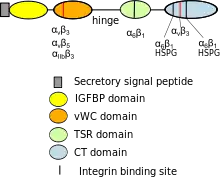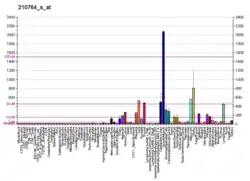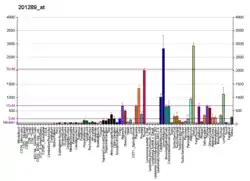CYR61
القاءکنندهٔ شمارهٔ ۶۱ رگزایی غنی از سیستئین (انگلیسی: Cysteine-rich angiogenic inducer 61) یا «عضو شمارهٔ ۱ خانواده سیسیان» که با نامهای اختصاری «CYR61» و «CCN1» هم شناخته میشود یک پروتئین ماتریکسی-سلولی است که در انسان توسط ژن «CYR61» کُدگذاری میشود.[4]

این پروتئین در ماتریکس برونیاختهای ترشح میشود و با خانوادهٔ پروتئینهای سیگنالدهندهٔ CCN در ارتباط است[5][6] و کارش، تنظیم برخی از فعالیتهای مهم زیستمولکولی نظیر چسبندگی، تحرک، تزاید و تکامل سلولها، آپوپتوز و پیرشدن از طریق تعامل با «گیرندههای اینتگرین» و «پلیگلیکانهای هپاران سولفات» است.
در هنگام تکامل جنین، CYR61 برای شکلگیری دیوارههای قلب، تشکیل رگهای جفت و حفظ استحکام و یکپارچگی عروق ضروری است.
در دوران بلوغ نیز این پروتئین نقش مهمی در فرایند التهاب و ترمیم بافتها و زخم ایفا میکند و با بروز بیماریهایی که دارای التهاب مرمن هستند (همچون روماتیسم مفصلی، تصلب شرایین و نفروپاتی و رتینوپاتی مرتبط با دیابت) و همچنین بسیاری از انواع سرطانها مرتبط است.
رگزایی، بهسبب اهمیتش در اکسیژنرسانی و تهیهٔ مواد مغذی برای سلولهای سرطانی، یکی از فرایندهای مهم رشد تومورهاست.[7] پروتئین CYR61، یک القاءکنندهٔ پرقدرتِ رگزایی درونتنی است[8][9] و میتواند به رشد، تهاجم، زندهماندن، حرکت سلولها از جدار بافت پوششی، و متاستاز سرطان کمک کند.[10][11][12][13] افزایش بیان ژنی این پروتئین در سرطان پستان،[14] سرطان پروستات،[11] سرطان تخمدان[15] و اسکوآموس کارسینوما[16] (سرطان بافت پوششی) دیده میشود. از لحاظ بالینی، میزان بیان CYR61 با مرحلهٔ (stage) تومور، اندازهاش، درگیرشدن غدد لنفاوی و پیشآگهی ناگوارِ برخی از سرطانها از جمله سرطان پستان[14][17][18][19][20] و سرطان پروستات،[21] گلیوما،[22] سرطان معده[23] و اسکوآموس کارسینوما[16] در ارتباط است.
با این وجود، پروتئین CYR61 قادر به القای آپوپتوز و پیری هم هست[24][25][26] که هر دو از مکانیسمهای شناختهشدهٔ سرکوب تومور محسوب میشوند.[27] در نتیجهٔ با آنکه این پروتئین قادر به القای تکثیر سلولی در سرطان پروستات است، در عین حال، با کمک و همکاری پروتئین تریل (TRAIL)، قادر به نابودسازی آن هم هست.[28][11][29] پروتئین CYR61 در مورد برخی از سرطانها، نقش بازدارنده ایفا میکند که از آن میان، میتوان به «سرطان ریه از نوع سلول غیر کوچک» (NSCLC)،[30] «سرطان مخاط رحم»[31] و «ملانوما»[32] اشاره کرد.
منابع
- GRCm38: Ensembl release 89: ENSMUSG00000028195 - Ensembl, May 2017
- "Human PubMed Reference:". National Center for Biotechnology Information, U.S. National Library of Medicine.
- "Mouse PubMed Reference:". National Center for Biotechnology Information, U.S. National Library of Medicine.
- Jay P, Berge-Lefranc JL, Marsollier C, Mejean C, Taviaux S, Berta P (May 1997). "The human growth factor-inducible immediate early gene, CYR61, maps to chromosome 1p". Oncogene. 14 (14): 1753–7. doi:10.1038/sj.onc.1200986. PMID 9135077.
- Lau LF (October 2011). "CCN1/CYR61: the very model of a modern matricellular protein". Cell. Mol. Life Sci. 68 (19): 3149–63. doi:10.1007/s00018-011-0778-3. PMID 21805345.
- Jun JI, Lau LF (December 2011). "Taking aim at the extracellular matrix: CCN proteins as emerging therapeutic targets". Nature Reviews Drug Discovery. 10 (12): 945–63. doi:10.1038/nrd3599. PMID 22129992.
- Folkman J (2006). "Angiogenesis". Annu. Rev. Med. 57: 1–18. doi:10.1146/annurev.med.57.121304.131306. PMID 16409133.
- Babic AM, Kireeva ML, Kolesnikova TV, Lau LF (1998). "CYR61, product of a growth factor-inducible immediate-early gene, promotes angiogenesis and tumor growth". Proc. Natl. Acad. Sci. U.S.A. 95 (11): 6355–6360. doi:10.1073/pnas.95.11.6355. PMC 27701. PMID 9600969.
- Fataccioli V, Abergel V, Wingertsmann L, Neuville P, Spitz E, Adnot S, Calenda V, Teiger E (2002). "Stimulation of angiogenesis by cyr61 gene: a new therapeutic candidate". Hum. Gene Ther. 13 (12): 1461–1470. doi:10.1089/10430340260185094. PMID 12215267.
- Monnier Y, Farmer P, Bieler G, Imaizumi N, Sengstag T, Alghisi GC, Stehle JC, Ciarloni L, Blant S (2008). "CYR61 and αVβ5 Integrin Cooperate to Promote Invasion and Metastasis of Tumors Growing in Preirradiated Stroma". Cancer Res. 68 (18): 7323–7331. doi:10.1158/0008-5472.CAN-08-0841. PMID 18794119.
- Sun ZJ, Wang Y, Cai Z, Chen PP, Tong XJ, Xie D (2008). "Involvement of Cyr61 in growth, migration, and metastasis of prostate cancer cells". Br. J. Cancer. 99 (10): 1656–1667. doi:10.1038/sj.bjc.6604712. PMC 2584944. PMID 18941464.
- Kassis JN, Virador VM, Guancial EA, Kimm D, Ho AS, Mishra M, Chuang EY, Cook J, Gius D (2009). "Genomic and phenotypic analysis reveals a key role for CCN1 (CYR61) in BAG3-modulated adhesion and invasion". J. Pathol. 218 (4): 495–504. doi:10.1002/path.2557. PMID 19402132.
- Haque I, Mehta S, Majumder M, Dhar K, De A, McGregor D, Van Veldhuizen PJ, Banerjee SK, Banerjee S (2011). "Cyr61/CCN1 signaling is critical for epithelial-mesenchymal transition and stemness and promotes pancreatic carcinogenesis". Mol. Cancer. 10: 8. doi:10.1186/1476-4598-10-8. PMC 3027193. PMID 21232118.
- Xie D, Miller CW, O'Kelly J, Nakachi K, Sakashita A, Said JW, Gornbein J, Koeffler HP (2001). "Breast cancer. Cyr61 is overexpressed, estrogen-inducible, and associated with more advanced disease". J. Biol. Chem. 276 (17): 14187–14194. doi:10.1074/jbc.M009755200. PMID 11297518.
- Gery S, Xie D, Yin D, Gabra H, Miller C, Wang H, Scott D, Yi WS, Popoviciu ML (2005). "Ovarian carcinomas: CCN genes are aberrantly expressed and CCN1 promotes proliferation of these cells". Clin. Cancer Res. 11 (20): 7243–7254. doi:10.1158/1078-0432.CCR-05-0231. PMID 16243794.
- Kok SH, Chang HH, Tsai JY, Hung HC, Lin CY, Chiang CP, Liu CM, Kuo MY (2010). "Expression of Cyr61 (CCN1) in human oral squamous cell carcinoma: An independent marker for poor prognosis". Head Neck. 32 (12): 1665–1673. doi:10.1002/hed.21381. PMID 20848406.
- Tsai MS, Hornby AE, Lakins J, Lupu R (2000). "Expression and function of CYR61, an angiogenic factor, in breast cancer cell lines and tumor biopsies". Cancer Res. 60 (20): 5603–5607. PMID 11059746.
- Xie D, Nakachi K, Wang H, Elashoff R, Koeffler HP (2001). "Elevated levels of connective tissue growth factor, WISP-1, and CYR61 in primary breast cancers associated with more advanced features". Cancer Res. 61 (24): 8917–8923. PMID 11751417.
- Jiang WG, Watkins G, Fodstad O, Douglas-Jones A, Mokbel K, Mansel RE (2004). "Differential expression of the CCN family members Cyr61, CTGF and Nov in human breast cancer". Endocr. Relat Cancer. 11 (4): 781–791. doi:10.1677/erc.1.00825. PMID 15613452.
- O'Kelly J, Chung A, Lemp N, Chumakova K, Yin D, Wang HJ, Said J, Gui D, Miller CW (2008). "Functional domains of CCN1 (Cyr61) regulate breast cancer progression". Int. J. Oncol. 33 (1): 59–67. doi:10.3892/ijo.33.1.59. PMID 18575751.
- D'Antonio KB, Toubaji A, Albadine R, Mondul AM, Platz EA, Netto GJ, Getzenberg RH (2010). "Extracellular matrix associated protein CYR61 is linked to prostate cancer development". J. Urol. 183 (4): 1604–1610. doi:10.1016/j.juro.2009.12.006. PMC 3349619. PMID 20172544.
- Goodwin CR, Lal B, Zhou X, Ho S, Xia S, Taeger A, Murray J, Laterra J (2010). "Cyr61 mediates hepatocyte growth factor-dependent tumor cell growth, migration, and Akt activation". Cancer Res. 70 (7): 2932–2941. doi:10.1158/0008-5472.CAN-09-3570. PMC 2848876. PMID 20233866.
- Lin MT, Zuon CY, Chang CC, Chen ST, Chen CP, Lin BR, Wang MY, Jeng YM, Chang KJ (2005). "Cyr61 induces gastric cancer cell motility/invasion via activation of the integrin/nuclear factor-κB/cyclooxygenase-2 signaling pathway". Clin. Cancer Res. 11 (16): 5809–5820. doi:10.1158/1078-0432.CCR-04-2639. PMID 16115920.
- Todorovic V, Chen CC, Hay N, Lau LF (2005). "The matrix protein CCN1 (CYR61) induces apoptosis in fibroblasts". J. Cell Biol. 171 (3): 559–568. doi:10.1083/jcb.200504015. PMC 1626352. PMID 16275757.
- Jun JI, Lau LF (2010). "The Matricellular Protein CCN1/CYR61 Induces Fibroblast Senescence and Restricts Fibrosis in Cutaneous Wound Healing". Nat. Cell Biol. 12 (7): 676–685. doi:10.1038/ncb2070. PMC 2919364. PMID 20526329.
- Chen CC, Lau LF (2010). "Deadly liaisons: fatal attraction between CCN matricellular proteins and the tumor necrosis factor family of cytokines". J. Cell Commun. Signal. 4 (1): 63–69. doi:10.1007/s12079-009-0080-4. PMC 2821476. PMID 19898959.
- Schmitt CA (2003). "Senescence, apoptosis and therapy--cutting the lifelines of cancer". Nature Reviews Cancer. 3 (4): 286–295. doi:10.1038/nrc1044. PMID 12671667.
- Franzen CA, Chen CC, Todorovic V, Juric V, Monzon RI, Lau LF (2009). "The Matrix Protein CCN1 is Critical for Prostate Carcinoma Cell Proliferation and TRAIL-Induced Apoptosis". Mol. Cancer Res. 7 (7): 1045–1055. doi:10.1158/1541-7786.MCR-09-0017. PMC 2712585. PMID 19584265.
- Sakamoto S, Yokoyama M, Aoki M, Suzuki K, Kakehi Y, Saito Y (2004). "Induction and function of CYR61 (CCN1) in prostatic stromal and epithelial cells: CYR61 is required for prostatic cell proliferation". Prostate. 61 (4): 305–317. doi:10.1002/pros.20098. PMID 15389821.
- Tong X, Xie D, O'Kelly J, Miller CW, Muller-Tidow C, Koeffler HP (2001). "Cyr61, a member of CCN family, is a tumor suppressor in non-small cell lung cancer". J. Biol. Chem. 276 (50): 47709–47714. doi:10.1074/jbc.M107878200. PMID 11598125.
- Chien W, Kumagai T, Miller CW, Desmond JC, Frank JM, Said JW, Koeffler HP (2004). "Cyr61 suppresses growth of human endometrial cancer cells". J. Biol. Chem. 279 (51): 53087–53096. doi:10.1074/jbc.M410254200. PMID 15471875.
- Dobroff AS, Wang H, Melnikova VO, Villares GJ, Zigler M, Huang L, Bar-Eli M (2009). "Silencing cAMP-response element binding protein (CREB) identifies cysteine-rich protein 61 (CYR61) as a tumor suppressor gene in melanoma". J. Biol. Chem. 284 (38): 26194–26206. doi:10.1074/jbc.M109.019836. PMC 2758018. PMID 19632997.
- مشارکتکنندگان ویکیپدیا. «CYR61». در دانشنامهٔ ویکیپدیای انگلیسی، بازبینیشده در ۱۷ ژانویه ۲۰۱۸.



